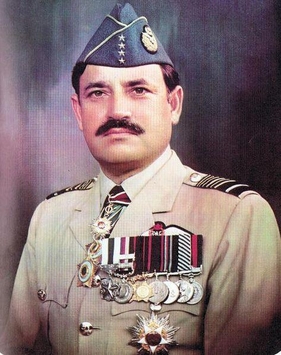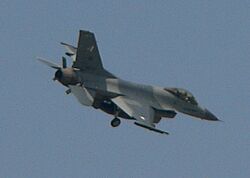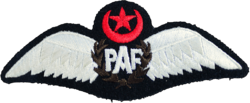Anwar Shamim facts for kids
Quick facts for kids
Air Chief Marshal
Anwar Shamim
|
|
|---|---|

ACM Anwar Shamim (1931–2013)
|
|
| Chief of Air Staff | |
| In office 23 July 1978 – 5 March 1985 |
|
| Preceded by | ACM Zulfiqar Ali Khan |
| Succeeded by | ACM Jamal Khan |
| Chairman of Shaheen Foundation | |
| In office 1982–1988 |
|
| President of Pakistan Squash Federation | |
| In office 1985–1988 |
|
| Personal details | |
| Born |
Mohammad Anwar Shamim
1 October 1931 Haripur, North-West Frontier Province, British India (Present-day, Haripur in Hazara District, Khyber-Pakhtunkhwa in Pakistan) |
| Died | 5 January 2013 (aged 81) CMH Rawalpindi in Punjab, Pakistan |
| Cause of death | Catastrophic illness |
| Resting place | H-11 Graveyard, Islamabad |
| Citizenship | |
| Nicknames | Shamim Fire Fighter M. Anwar Shamim |
| Military service | |
| Allegiance | |
| Branch/service | |
| Years of service | 1954–1985 |
| Rank | |
| Unit | No. 12 Squadron Globe Trotters (S/No. PAK/ 3657) |
| Commands | Missile Guidance Program Air Force Strategic Command Southern Air Command Masroor Air Force Base ACAS (Air Operations) at Air AHQ |
| Battles/wars | Indo-Pakistani war of 1965
Jordan–Palestine conflict in 1970 Indo-Pakistani war of 1971 Soviet–Afghan War |
| Awards | |
Air Chief Marshal (ACM) Mohammad Anwar Shamim (born October 1, 1931 – died January 4, 2013) was a very important air officer in the Pakistan Air Force (PAF). He served as the Chief of Air Staff from 1978 to 1985.
Born in Haripur, British India, he became a skilled fighter pilot. He took part in conflicts with India in 1965 and 1971. He also helped as a military adviser to Jordan in 1970.
As Chief of Air Staff, Shamim worked to make the PAF stronger. He helped Pakistan get F-16 fighter jets from the United States in 1983. He also got radar technology to improve Pakistan's air defense. He was a key adviser to President Muhammad Zia-ul-Haq on national security.
Anwar Shamim was the second longest-serving Chief of Air Staff in the Pakistan Air Force. He passed away in January 2013 and was buried with full state honors.
Contents
Biography
Early Life and Education
Anwar Shamim was born in Haripur, British India, on October 1, 1931. His parents were teachers. He went to Government College in Attock. Later, he joined the University Air Squadron of the Royal Air Force.
In 1950, he joined the RPAF College in Risalpur. He was then chosen to train at the Royal Australian Air Force College. In 1952, he became a Pilot Officer in No. 12 Squadron. He also trained in the United States to fly the F-104 Starfighter. In the 1960s, he studied Defence studies at the Air Command and Staff College in Alabama.
In the 1970s, he earned a master's degree in national security from the National Defence University in Islamabad.
Military Career and Key Roles

In 1963, Squadron-Leader Shamim led No. 11 Squadron Arrows. In 1965, as Wing-Commander, he commanded No. 33 (Tactical) Wing. He played a role in the Indo-Pakistani war of 1965. He flew his Lockheed F-104 Starfighter and North American F-86 Sabres against the Indian Air Force. His team carried out many attack and bombing missions.
After the 1965 war, Group Captain Shamim became an air adviser to the Royal Jordanian Air Force in 1967. He advised King Hussain of Jordan on air superiority during the Six-Day War. In 1970, he helped the Jordanian Armed Forces by gathering military intelligence during a conflict in Jordan. King Hussain praised his efforts.
In 1971, Gp. Capt. Shamim returned to Pakistan. He was made base commander of Masroor Air Force Base. He focused on aerial defense and directed air operations.
From 1974 to 1976, Air Commodore Shamim was the Air Officer Commanding of the Southern Air Command. Later, he became ACAS (Air Operations) at the Pakistan Air Headquarters (AHQ). In 1978, he was promoted to Air Marshal.
Chief of Air Staff
On July 23, 1978, Anwar Shamim became the Chief of Air Staff. He was promoted to Air Chief Marshal (ACM). President Fazal Ilahi approved his promotion.
As Chief of Air Staff, ACM Shamim worked to modernize the air force. He aimed to get new fighter jets from the United States and China.
He served for a long time, with two extensions to his term. The first was in 1982 to oversee the arrival of F-16A/B jets. In 1983, he received another extension. This made him the longest-serving chief of the air force at that time.
Under his command, the PAF flew missions against Soviet Air Forces jets that entered Pakistan's airspace. However, he did not allow F-16s to chase them into Afghanistan.
F-16 Fighter Jet Program

In 1979, ACM Shamim told President Zia-ul-Haq that a key research site was vulnerable. He suggested getting American F-16s to protect Pakistan's nuclear deterrence. He pushed hard for the F-16s and refused other aircraft options. In 1980, he successfully negotiated with China to get Shenyang J-6s for defense.
The Pakistan Ministry of Defence and the United States Department of Defense discussed the F-16 deal. Air Chief Marshal Shamim then launched Project Falcon.
On January 15, 1983, the first three F-16As arrived in Pakistan. ACM Shamim issued a secret memo. It stated that any attack on Pakistan's nuclear sites would be met with F-16 retaliation. He also worked closely with Lieutenant General Arnold W. Braswell of the United States Air Force.
After Israel's airstrike on Iraq's nuclear plant, Pakistan worried about a similar attack. ACM Shamim then created the Air Force Strategic Command (AFSC). This command was to protect Pakistan's nuclear facilities.
In 1980, ACM Shamim also oversaw the arrival of the A-5 Fantan jets into the PAF. The first squadron arrived in 1981. In 1982, he acquired more Dassault Mirage 5 jets to support the Pakistan Navy's air defense.
Air Force Strategic Command
After Israel's successful airstrike on Iraq's nuclear plant, Pakistan's intelligence community worried. They thought India might try to destroy Pakistan's nuclear sites. Because of this, ACM Shamim increased security for the nuclear facilities. He did this by setting up the strategic air command.
The Air Force Strategic Command was mainly responsible for protecting the country's secret nuclear deterrence. This command later took over satellite operations. It provided money to develop Badr-1, Pakistan's first communication satellite.
Retirement and Later Life
In 1985, ACM Shamim decided not to accept another extension as Chief of Air Staff. President Zia-ul-Haq had approved a third extension. ACM Shamim was succeeded by Air Chief Marshal Jamal Khan. He then settled in Islamabad, Pakistan.
In 1986, President Zia appointed Shamim as Pakistan's High Commissioner to Canada. However, the Canadian government did not accept his appointment. In 1987, he was also considered to be Pakistan's Ambassador to Saudi Arabia, but this was also refused.
In 1988–89, he wrote articles for the Dawn newspaper. He wrote about security issues in Afghanistan.
In 2010, he published his book, Cutting Edge. In it, he shared his memories from his time as air chief.
Death and State Funeral
On January 3, 2013, Shamim was admitted to the Combined Military Hospital Rawalpindi. He passed away on January 4, 2013, after a long illness. The Government of Pakistan announced that he would receive a state funeral.
His state funeral was attended by many important people. These included Air Chief Marshal Tahir Rafiq, Admiral Asif Sandila, and General Ashfaq Parvez Kayani. Former air chiefs, war veterans, and diplomats also attended. President Asif Zardari praised Shamim's service to the nation.
Anwar Shamim is buried in H-11 Graveyard, Islamabad. A granite memorial with the Pakistan Air Force emblem marks his grave.
Legacy
ACM Anwar Shamim is remembered as the second longest-serving chief of air staff. He led the air force for almost seven years. During his time, the F-16 jets were brought into the air force.
ACM Anwar Shamim also started air force exercises that worked with other parts of the Pakistani military. This helped leaders understand what the PAF could do.
Awards and Decorations
 |
|||
See also

